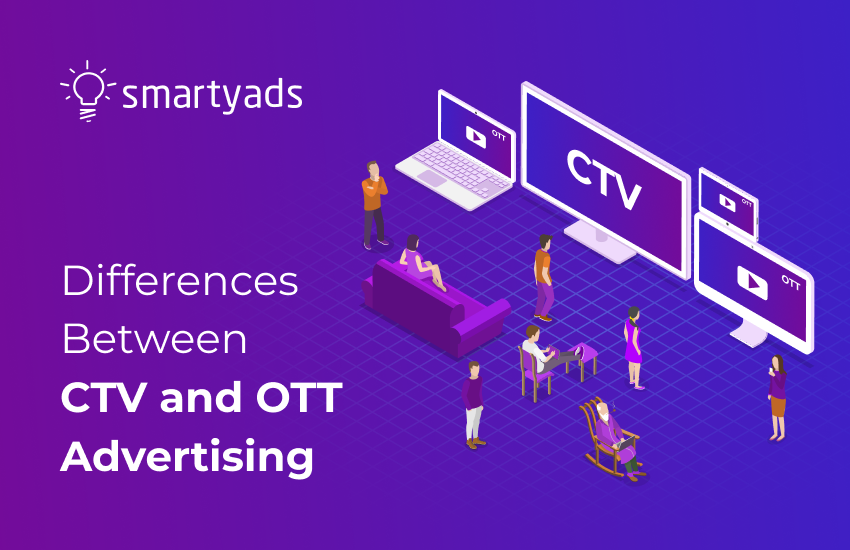Multichannel digital advertising is one of the most important approaches for brand promotion. However, to implement such a strategy effectively, it's necessary to distinguish these channels.
When you say CTV, do you mean the big smart TV in your living room where you're rewatching The Big Bang Theory on Apple TV? Or do you mean you subscribe to a dozen streaming services to watch video content?
And when you talk about OTT, do you mean a TV connected to the Internet or that new show you started watching on Hulu?
Many people and even many marketers put an equal sign between OTT and CTV in casual conversations. Nevertheless, you need a deeper understanding of these concepts to set up multichannel advertising.
What is OTT?
OTT literally means "over-the-top", which can be decoded as "over-the-box". Content for OTT is streamed through an Internet connection, so viewers don't have to subscribe to a traditional linear TV provider to access it.
The content is provided as streaming video or through video-on-demand (VOD) services. Some of the most well-known OTT streaming platforms are Netflix, Hulu, Crave, and Amazon Prime.
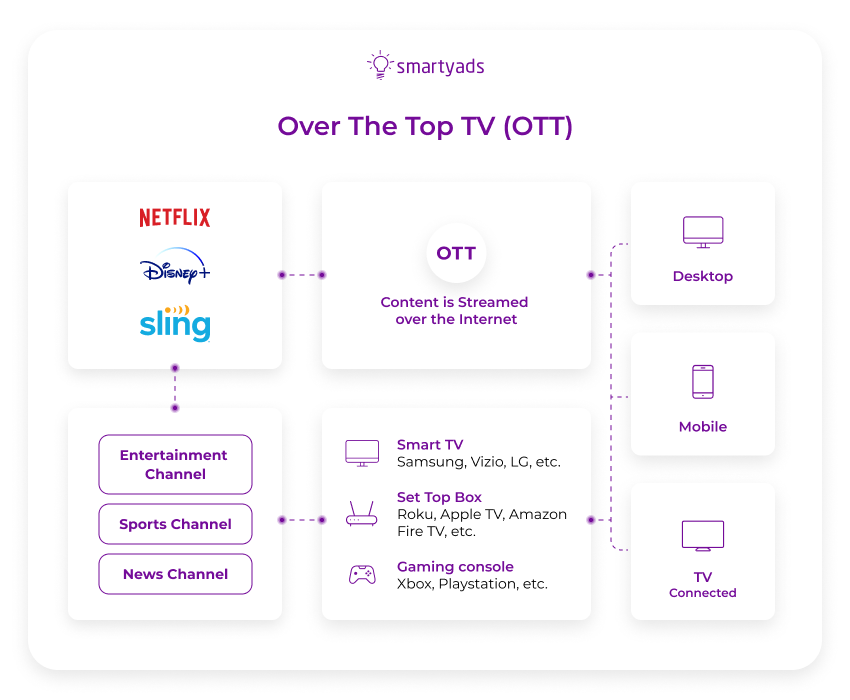
We have already reviewed top OTT services so that it will be easy for you to make a choice.
Many major companies have also adopted this type of video content delivery and are creating their own OTT services and even apps.
For example, in 2019, Disney launched their Disney+ service, and in 2020, NBC Universal launched an OTT service called Peacock. So OTT advertising means that your ads are displayed on these OTT services.
The main difference from traditional linear TV is that as long as the users have some OTT devices with Internet access (mobile phone, tablet, laptop, smart TV, and over-streaming devices), they will have access to OTT TV content.
Traditional television, on the other hand, would require users to subscribe to a provider.
What is CTV?
The term CTV (Connected TV) refers to any type of TV that supports digital video streaming — for instance, Smart TVs.
Roku or Chromecast, Apple TV, Amazon Fire TV Stick, and gaming consoles such as Xbox and Nintendo Switch can also serve as examples. The main thing you need to understand in order to differentiate OTT and CTV is that most over-the-top TV content can be watched through CTV devices.
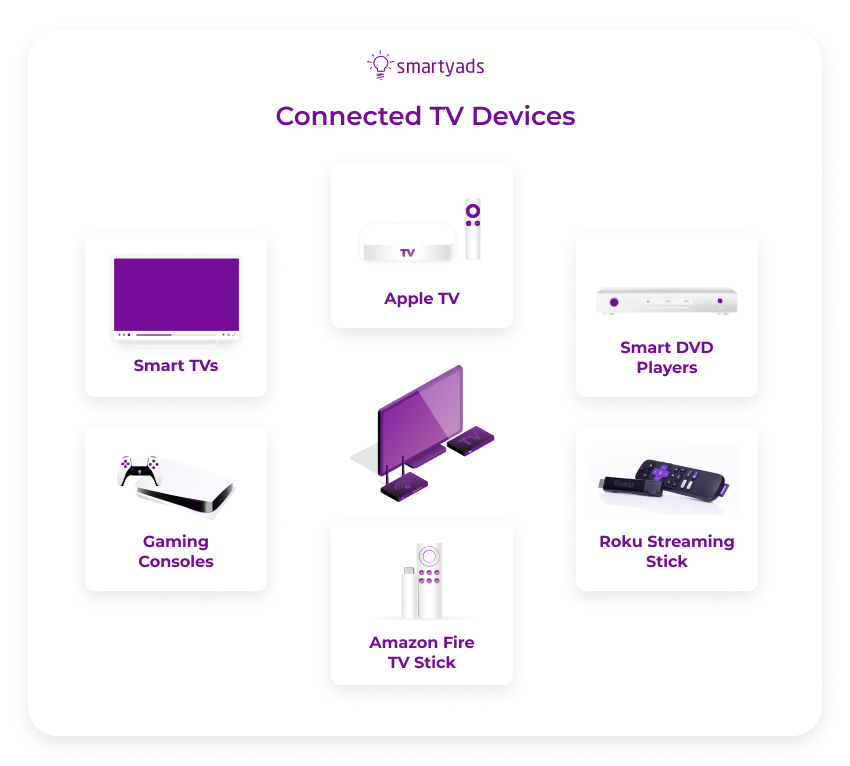
Because of the popularity of Connected TV, there is such a thing as "cable-cutting". It means that users prefer abandoning cable or satellite subscriptions in favor of video streaming services.
Streaming content is often cheaper than a paid TV subscription or even free, so this choice is usually based on savings.
In 2020 alone, 6 million households in the U.S. gave up linear and satellite providers in favor of connected television. That brings the total number of households that have abandoned traditional TV to 31.2 million.
OTT vs CTV
Let's review the key differences between OTT and CTV to understand what role they can play in advertising.
CTV is a subset of OTT programming. That means that OTT is a method of delivering video content, and CTV is the device on which the viewer can see that content.
For example, if viewers watch streaming OTT content on their mobile devices, they receive over-the-top TV content.
However, if they watch it with a Connected TV device, they now consume OTT content through the CTV. In this case, the user can see both OTT and CTV ads.
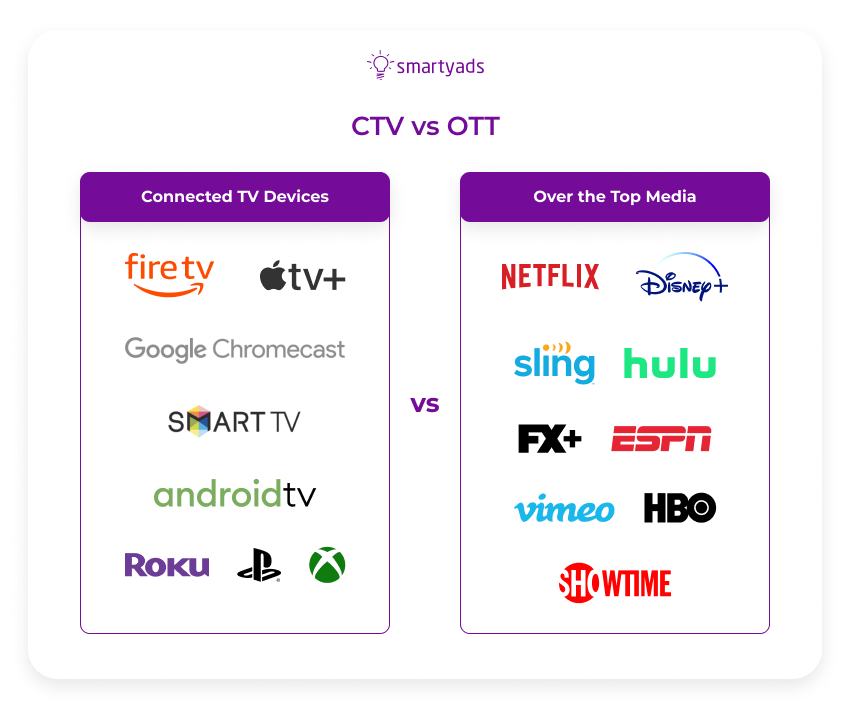
OTT and CTV: the role in advertising
As an advertiser, you're interested in the potential of OTT and CTV ads.
Here, you can find a detailed guide on OTT advertising, and this article will provide you with actionable insights on CTV advertising.
At the moment, let's explore the viability of such ads.
Is there a future for CTV and OTT advertising?
A short answer is yes — to remain competitive and reach your customers across multiple channels, you can implement CTV or OTT advertising (or both). Here are several statistical facts to prove this.
The number of people using CTV continues to grow. The majority of households in the U.S. have at least one Connected TV in their home. More and more customers are purchasing Connected TV devices, and most use them to access OTT platforms.
In addition, spending on CTV advertising continues to grow:
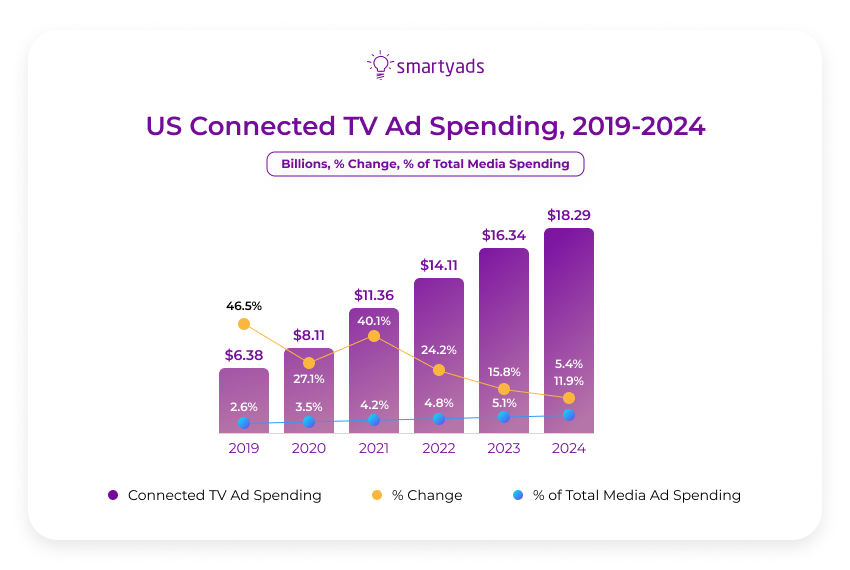
The platforms U.S. brands prefer to invest in are as follows:
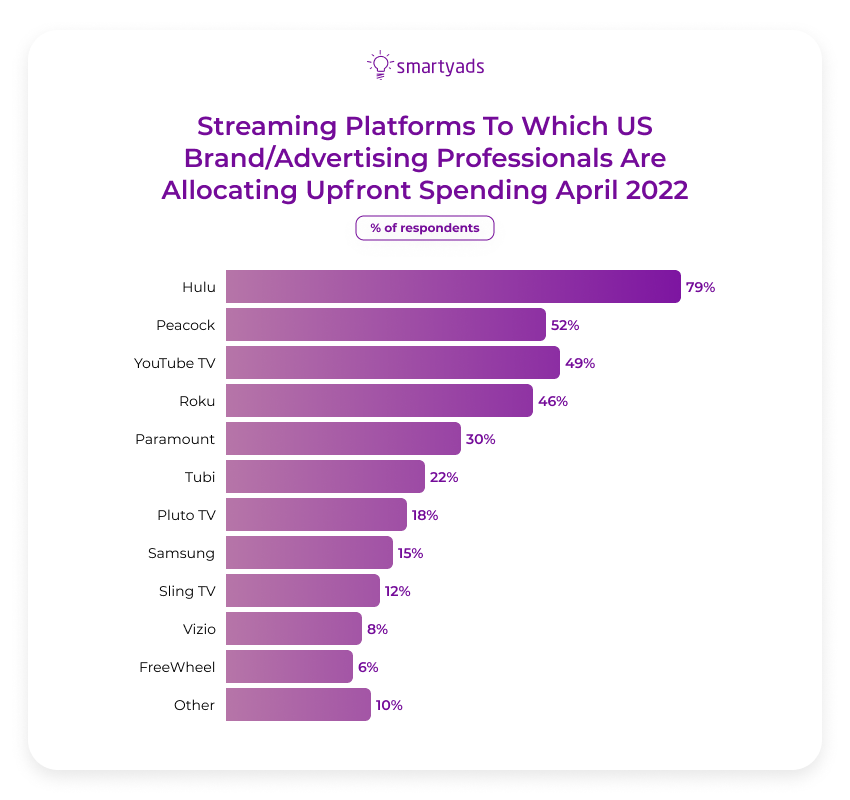
So, the niche of this type of advertising remains very promising and popular while traditional television is steadily leaving the stage.
However, the increasing number of CTV users is not the only reason for launching OTT and CTV campaigns.
Why leverage CTV and OTT ads
CTV advertising can be purchased programmatically, so your DSP (demand-side platform) probably offers CTV as one of the media channels.
OTT opportunities can also be taken via DSPs since you will deliver ads to users accessing streaming services via CTVs.
Let's review the advantages and challenges of OTT and CTV advertising performed via DSPs and compare it with launching commercials on traditional TVs.
CTV and OTT campaigns: benefits
High view completion rates
Most of the CTV or OTT ads cannot be skipped. Sometimes, this is possible, but users have to press the little cross in the corner of the TV screen, which is extremely uncomfortable to do with the remote.
This means an opportunity for you and a better chance that your ads will be seen. For this reason, Connected TV advertising has a very high view completion rate.
On the other hand, linear TV is increasingly providing a service that allows the viewer to scroll through or skip an ad. And live TV viewing is decreasing year over year, as is the ability of viewers to watch traditional TV commercials.
Campaign settings
Because CTV advertising is a part of programmatic advertising, the possibilities of its setting are much wider and more varied than the opportunities of setting up ads on traditional TV.
There are no limitations related to broadcasting time or advertising prices.
The CTV campaign settings are the same as for native or video ads. There are also advanced targeting options and a more comprehensive selection of inventory.
With real-time reporting, you can track user interactions with your ads as long as the campaign is active and adjust settings if necessary. As for ads on traditional TVs, you can never predict who will see them.
Brand safety
The DSP platforms that set up advertising campaigns for Connected TV carefully select and verify the publishers where the ads will be displayed. In addition, the platform's tools allow you to choose your desired publishers if needed. This way, your brand's reputation will be safe.
Ad spend
On linear TV, the cost of advertising is fixed, unlike on OTT and CTV. Here, the cost of the display will be determined based on real-time bidding, which is part of the DSP's service.
Thanks to this, advertising on Connected TV is much more profitable. Besides, you can set the maximum price for the display, which will make you more reasonable in your advertising budget control.
Creative advertising
With the video format, advertising can be very creative on its own. But with CTV ads, there's a lot more opportunity to make a catchy one because of the interactivity. You can add a button or QR code to get viewers more engaged.
For example, the cryptocurrency exchange Coinbase ran an ad during Super Bowl 2022 where a QR code moved across a black screen, bouncing off its borders.
The ad resembled an old video game, and it was so popular that in a few minutes, Coinbase faced server overload because of the huge incoming traffic.
Here, you can find the best CTV ad examples to gain some inspiration.
Retargeting options
Since the advertising setup options on Connected TV are very high, you can use existing customer bases to launch your advertising campaigns.
In turn, for traditional TVs, retargeting is impossible.
Targeting multiple devices
Your advertising message can communicate to users better if they see it on multiple connected devices.
Connected TV audience targeting will amplify the message and increase the visibility of the brand or product you're advertising.
Potential challenges
- The number of households with CTV has not reached the number that has used terrestrial and traditional cable television. However, the world is moving toward it very quickly. But while we're not there yet, it's also worth considering.
- Many platforms and data providers can't map cookies or mobile advertising identifiers (MAIDs) to IP addresses, which limits the scale of inventory available for IP-based audience targeting.
- Lack of audience fragmentation due to hidden account sharing. Since many families, friends, or partners often use the same account to watch streaming content, targeting a specific demographic group of customers can be difficult. However, it's still much better than the targeting (or lack thereof) on linear TV.
Final thoughts
OTT and CTV have different definitions, but in terms of advertising, they often go hand in hand since you can reach users viewing OTT content on their CTVs.
To use or not to use this type of advertising? There's no one-size-fits-all answer. As always, it all depends on the needs of your brand and your marketing goals.
Launching CTV and OTT campaigns can help you enhance reach and, therefore, drive sales. However, the decision regarding implementing this advertising strategy should be data-driven, and it's essential to continuously monitor the performance to understand if this channel is bringing the desired results.
Do CTV and OTT ads sound like something you need right now? We'd be happy to help you with our SmartyAds DSP.
FAQ
Here are the key steps to take:
- Analyze your audience to ensure effective targeting;
- Keep your ads short but memorable and interactive;
- Come up with a compelling message;
- Select trusted platforms;
- Continuously measure the performance of your ads and optimize your campaigns.
To make the choice, learn more about your target audience and find out what devices they use to consume video content. For instance, if they watch Netflix on a Connected TV, CTV advertising is the way to go. If they prefer to use their smartphones, you should choose OTT advertising.
Define your audience and their expectations, design creative clickable ads with strong CTAs, set up targeting, and test your campaigns to identify the most efficient approaches. Note that using programmatic solutions can help you automate certain tasks and reach viewers more effectively while getting the most relevant ad space.
